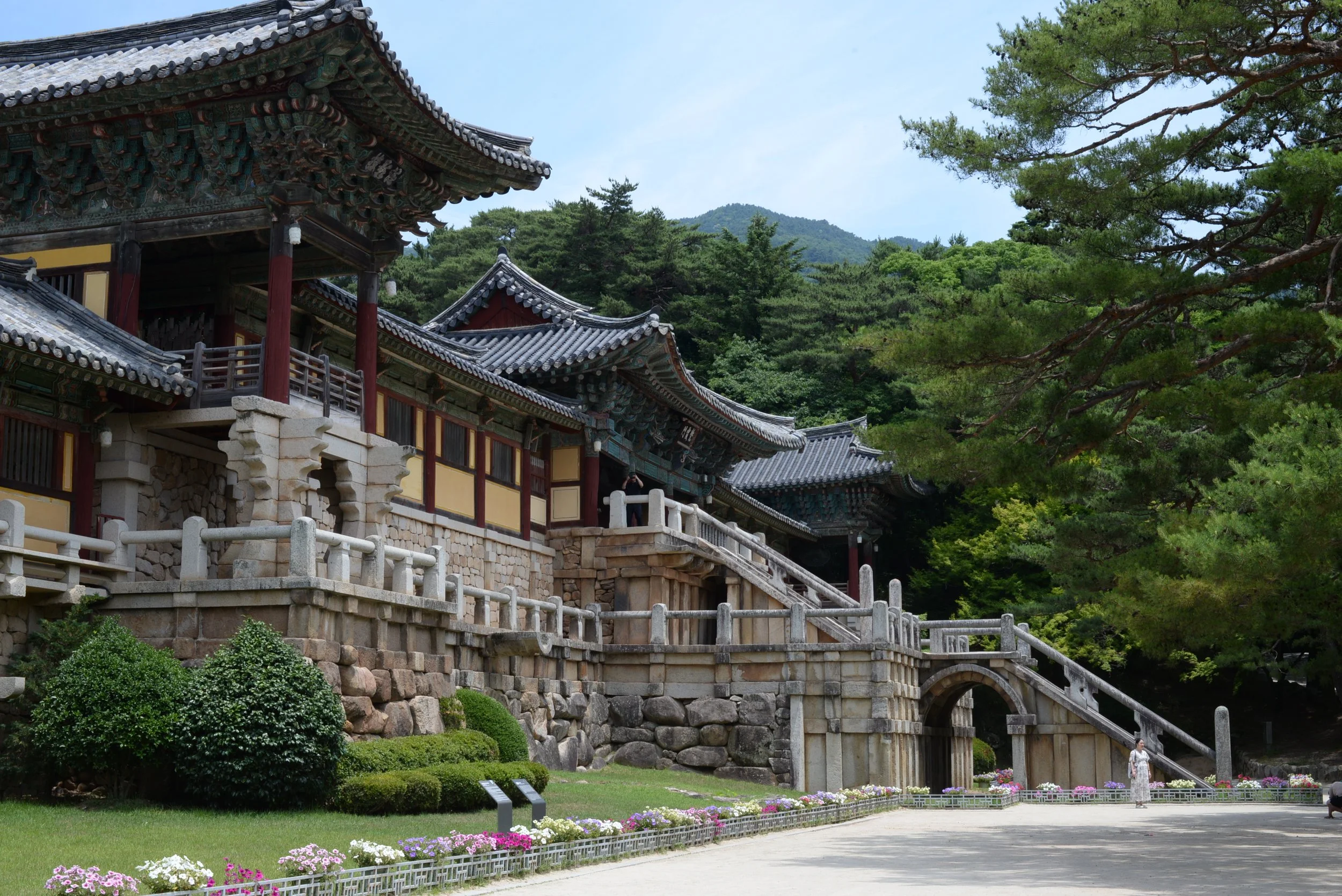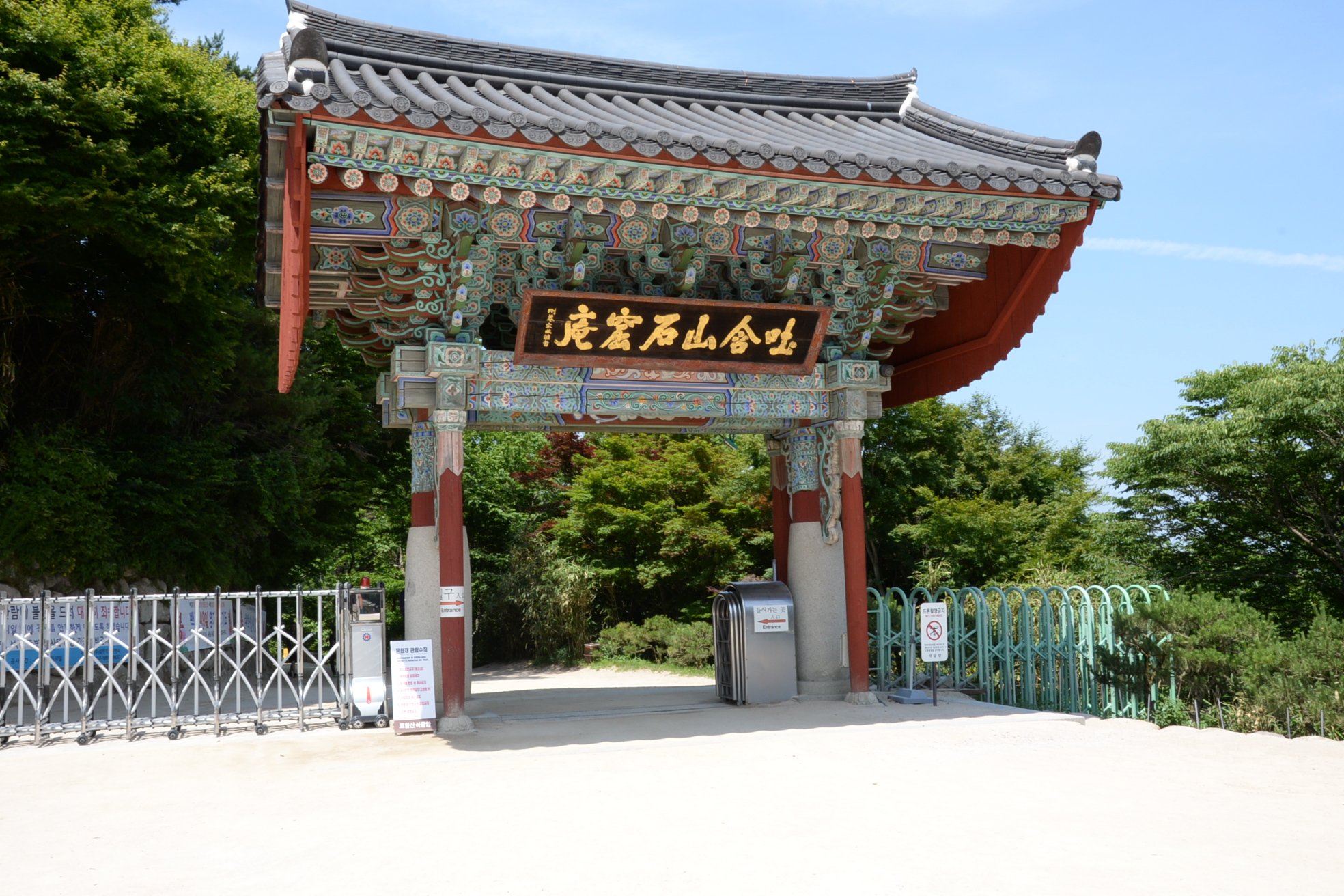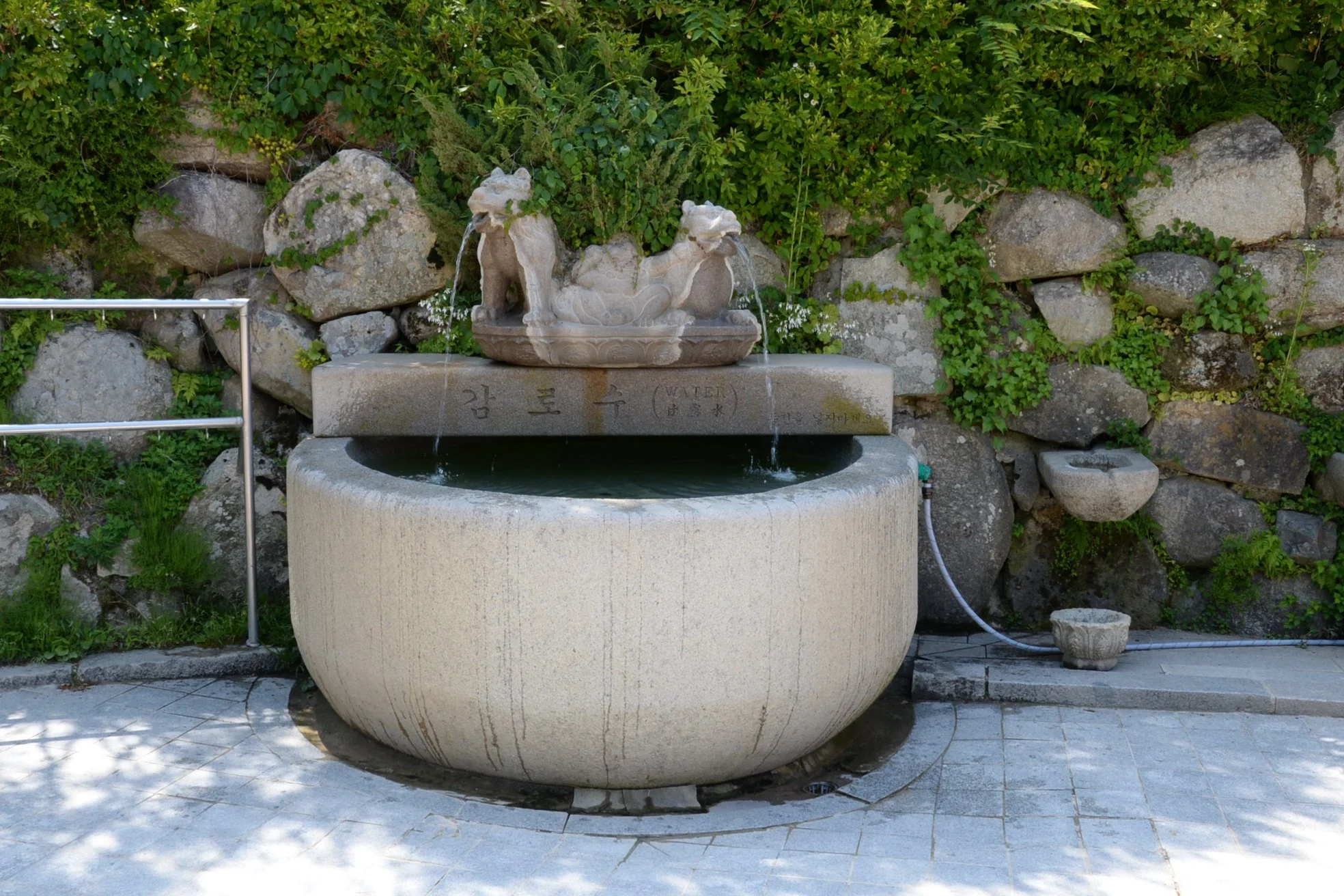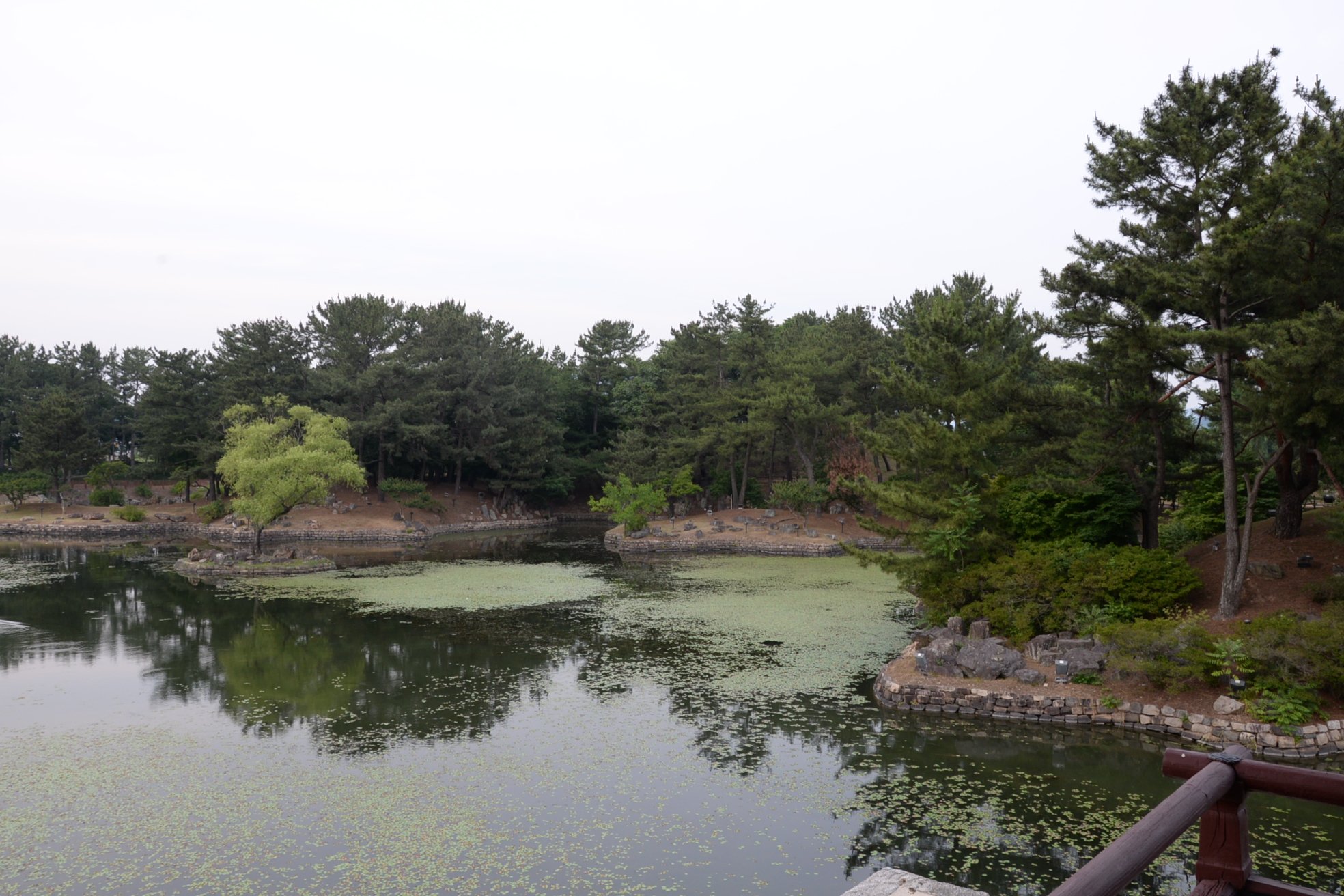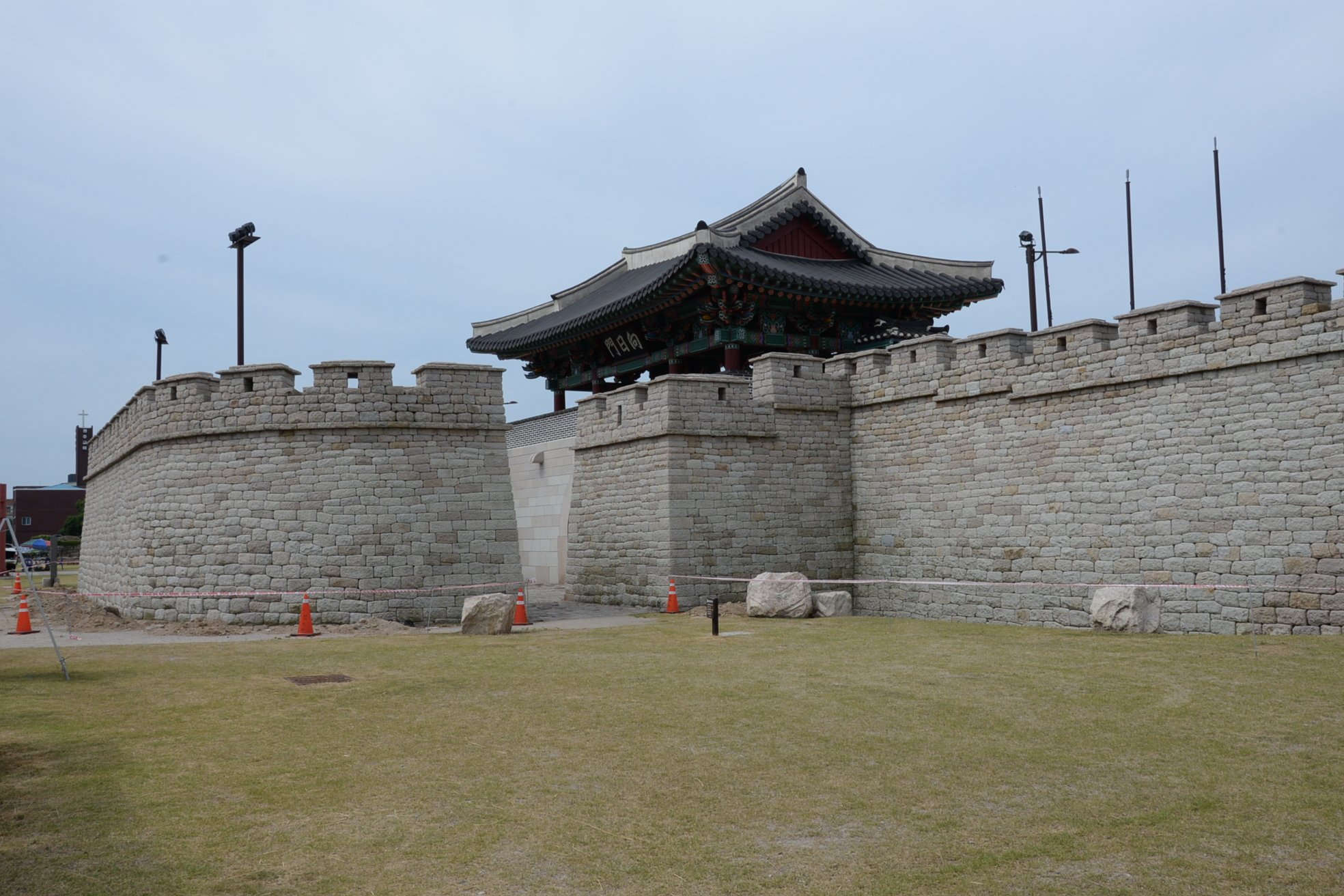Gyeongju (경주)
Silla’s capital for nearly a millennium, the ancient city formerly called Seorabeol continues to stun visitors with a charming display of ancient and medieval Korean art, architecture, and grandiosity. Despite having lost its status as national capital with the establishment of Goryeo in 935, and its seizure in 1592 by invading Japanese forces, Gyeongju has, against all odds, managed to maintain its allure.
Bulguksa Temple (불국사)
The iconic, Silla-Era temple with the unique and immediately recognizable facade lies just southeast of Gyeongju. Founded in 528 AD, Bulguksa was burned to the ground during the latter half of the Imjin War by vengeful Japanese troops. Reconstruction began in 1604 with various additions and renovations taking place until 1805 and has remained in operation since.
The pond and garden area beyond the gateway to Bulguksa are simply beautiful.
The temple gate houses the usual collection of guardian statues, and beyond, a short, straight, tree-lined walkway to the temple itself.
The stone staircase leading up into the main hall of Bulguksa.
You’ll find the facade of Bulguksa everywhere in Korea as it is truly unique…to say nothing of beautiful.
Particularly with college entrance exam season upon us, the wishes of visitors literally crowd out the ceilings of all Bulguksa hallways.
The more ornate of Bulguksa’s two stone pagodas.
More wishes, this time suspended by colorful lanterns.
Bulguksa’s second stone pagoda.
The main hall at Bulguksa.
Everywhere in and around Gyeongju, it seemed, we found Big Bronze Bells (B3) suspended in ornate towers.
Not far from Bulguksa—by foot…if you drive its a whole other thing—lies the Seokulam, a significant example of Silla-Era grotto Buddhist statuary. Overlooking the parking lot there we found another B3…this one even bigger than the last!
Gate to the short trail to the temple and man-made cave.
As we approached, this was the only view we had of the small building guarding the entrance to the cave.
And here up close. Unfortunately, no cameras were allowed inside.
Only the second time I’ve ever included a photo in these galleries that neither I nor my wife took ourselves. This picture of the inside of the grotto was taken by 문화재청 and can be found at: https://commons.wikimedia.org/w/index.php?curid=106913440
Cheomseongdae (첨성대)
This odd-looking tower was built for the purpose of analyzing the movement of the stars in the 7th Century AD, reportedly during the reign of the famous Silla Queen Seondeok. Modeled on Baekje’s Jeomseongdae—of which nothing remains today—it was itself the model for observatories subsequently built in Japan and China. As such, the Cheomseongdae is the oldest surviving astronomical observatory in Asia.
Like most of the MANY historical attractions to be found in Gyeongju, the Cheomseongdae is lit up dramatically at night.
Interestingly, while tourists visit the Gyeongju sites all day long, as darkness falls, the flow of buses actually increases and even more people flock to the spectacularly lit-up sites.
Weolseong Fortress (월성)
While its precise date of construction remains unclear, modern researchers believe it was built early in the 4th Century AD. The high, earthen walls—Weolseong was never clad in stone—make it the best surviving example of what all Korean Three Kingdoms fortifications looked like before the introduction of masonry. Within the high walls Weolseong housed the royal palace, making it the governmental center of Silla (both the Three Kingdoms entity and Unified Silla) for over 500 years.
From a distance Wolseong—also known as Banwolseong, Sinwolseong, and Jaeseong—has the appearance of a low, flat hill mass, though one of the gates can be seen on the right hand side of the picture. All the flat area in the foreground would have been filled with buildings and courtyards dedicated to the administration of the small kingdom of Silla and, later, the much larger entity that we now call Unified Silla.
A closer view of the gate mentioned above. The tiny human figure on the path gives some idea of how high those dirt walls really were!
Given the large number of governmental buildings that once would have crowded this photo, its unsurprising that thought was given to drainage. This photo looks east.
Here the small, stone-lined ditch leads west into the Gyerim Forest separating the royal residence from the ancestral tombs.
The south side of Weolseong is protected by the Namcheon stream and on the north by a series of interconnected moats, channeling any approach of the well-defended fortress gates. This photo looks east.
This one looks west. Both were taken from just below the yawning gate.
The path into Weolseong threads a pair of moats and then up and into the earthen walls. The wall on the left is MUCH higher than the right, nearly 50 feet high!
Several locations within Weolseong and around Gyeongju show signs of active archeaological excavation. This is a section of the fortress wall just east of the Weoljeonggyo bridge.
What appears to be another gate through the Weolseong walls, fronted by Namcheon.
Another view of the southern walls of Weolseong, beyond the Namcheon stream. An interesting thing about this watercourse: apparently the local sand carries lots of quartz, thereby creating an odd effect. Early residents used to swear that the sandy streambed was actually moving in the opposite direction from the flow of water above it…something to do with how light passing through the moving water struck the quartz.
Views of the high eastern end of Weolseong.
Back at the northeastern corner of the fortress. Foundation stones for governmental buildings can be seen in the foreground.
Donggung Palace & Weolji Pond (동궁 과 월지)
One of my favorite reasons to visit Gyeongju…and that was before I’d even seen it at night! Donggung palace and Weolji Pond are beautiful any time of day. But the light show after hours is breathtaking! Constructed in 674 AD, the site is exactly what it was intended to be…magical. Neither words nor pictures do the place justice!
We’d been to Donggung Palace before, but only during the day. This time, after walking the entire grounds, we settled down to await darkness. As we waited, the number of visitors increased dramatically, and by the time we departed around 2030 or so, whole buses were still arriving on the scene to take in the illuminated scenery.
The beauty—if not outright majesty—of the setting gets more alluring the darker it gets. Hat’s off to the Gyeongju City board of tourism. This is how you highlight history!
Needless to say…we took hundreds of pictures at this site alone!
Weoljeonggyo Bridge (월정교)
The main bridge across the Namcheon Stream led directly into Seorabeol (Gyeongju) below the high walls of Wolseong. Constructed during the reign of King Gyeongdeok (742-765), the bridge survived for several hundred years. The exact design of the bridge was never recorded and so the current reconstruction is a best guess based on Silla designs of the time and material evidence found by archaeologists on the site.
A beautiful structure…there’s just not a lot more I can say!
Myeonghwalseong (명활성)
Of course, none of my trips would be complete without visiting at least one mountain fortress or sanseong. Myeonghwalseong was one of a system of four fortresses that provided internal security of the capital—one constructed along each of the four cardinal directions. Myeonghwalseong lies to the east. Its precise date of construction is unknown, but records indicate it was attacked by Yamato-era Japanese marauders as early as 405 AD.
Originally a rammed-earth fortress, a stone tablet found at the site indicated that in 551 Myeonghwalseong was clad in stone, a not unheard of practice as masonry techniques proliferated during the Korean Three Kingdoms era.
According to the annals, troops from Yamato Japan twice landed on the east coast and attacked Myeonghwalseong, in 405 AD and again in 431. It was also the headquarters of a rebellion led by Bidan during the reign of Queen Seondeok (702-737). That rebellion was put down by none other than the famous Silla General Kim Yu Sin.
Restoration work began only a few years ago and thus far only four stretches of the fortress have been rebuilt, including this gate. The best sign (for me at least) that more restoration work is intended is the large parking lot and restroom being built a couple hundred meters away from here.
The stepped style of wall construction instantly reminded me of the walls of Sabi (Buyeo), Baekje’s capital, and extant with the walls of Myeonghwalseong. As such you’ll note these walls utilize uncut stone, giving them a unique, almost random appearance. The newer sections are immediately recognizable due to the light, unweathered nature of the stone used…contrasting sharply with the much darker original stone found EVERYWHERE around the site.
Looking out from just inside the gate, that’s the new parking lot there in the distance.
The largest length of restored wall is there where you enter the gate. Walking up the gentle slope, you quickly find the elegant curving walls of the Three Kingdoms Era…built with stone above ground level in the manner seemingly favored by Silla.
Beyond the restored areas the wall devolves into its former, rammed earth self, though with tons of evidence of the stone facade it once sported.
The second of four restored sections. I’m guessing they chose locations that would be visible from the main road below as otherwise it all seemed a bit random.
At certain spots, the sheer amount of rubbled out stone was telling, but stone or no stone, the solid construction of Myeonghwalseong’s earthen core was easy to follow.
The third renovated section.
This was the scene along the hiking trail we followed, providing evidence of the sheer amount of stone that once made up this incredible fortress.
At a couple spots across the trail from the wall itself, we found clear indications of masonry work done to flatten an area, presumably to support a watch tower or other such construct.
Back at the gate, we found an interesting—if newly finished—feature. The drainage ditch was newly dug, obvious by the square patches of sod sewn into the walls to mitigate against erosion. But the lay of the land here would seem to indicate a likely place for water to naturally drain from the heights above.
Finding what looked like a smaller—older—ditch feeding into it, we could only guess that the restoration crew had simply re-dug irrigation channels their forebears had put in place some 1,600 years ago. Might not mean much to you…but it fascinated us!
Gyeongju City Walls (경주읍성)
The city walls of Gyeongju were long since toppled and built over. However, a short stretch of medieval wall had been spared, and that sliver is now being expanded upon by construction crews and historians. The intent is to rebuild as much of the old, square-shaped city walls, as possible. With APEC 2025 coming to the city next year, work is ongoing to complete this and other restoration projects in time to showcase them at that Asian forum.
A relative baby by the standards of Gyeongju, the city walls, or eupseong, of Gyeongju were constructed in 1012, during the Goryeo period. This gate faces west and is the only gate complex as yet restored.
Featuring the typical Joseon era protective wall around the outside of the gate itself, the portal’s reconstruction is coming along nicely.
Here they’ve left a bit of the old, wall and a single, run-down turret, in state. The line between dark and light stone shows clearly how much of the wall had to be restored…and what bad shape this remnant was in.
That said, as you can see, the current project adds a couple hundred meters of wall to the current gate complex, complete with defensive turrets common amongst Joseon era city fortifications and informational signage. Given the large number of projects underway around Gyeongju, we’ve already planned our next trip to the city once the wave of APEC visitors has subsided. Can’t wait to see how it all looks!
Gyeongju Royal Tombs
The royal tombs of Silla are impossible to ignore. They are literally everywhere you look, especially near Wolseong and the palace. Following burial practices used in early China, these burial mounds were carefully constructed, and each holds the remains of a king, a queen, or other senior aristocrat. Some tombs included double mounds and burial chambers, one each for the king and his queen. With the spread of Buddhism in the 7th and 8th Centuries—and resultant shift toward cremation—the construction of these majestic burial mounds faded away.
This tomb, called the Cheonmachong, was special in that visitors can walk inside to better understand: 1) how they were made and 2) what lay within.
Within each of the many, MANY tombs we saw across Gyeongju lies a wooden burial chamber. Stone was packed around it, a layer of clay installed to make it waterproof, then a layer of dirt to complete the shape of the mounds we see today.
A king was buried in full regalia, including many articles of gold, Silla’s most famous and desired product. The wooden chamber was sealed and then covered, leaving this hollow room in the center of each of Gyeongju’s royal tombs.
As with most things in Gyeongju…the tombs only get more beautiful after dark!
Queen Seondeok’s Tomb (선덕여왕릉)
Queen Seondeok is a fascinating historical figure from a fairly unique political structure—one that allowed ascension to the throne of female royalty. Seondeok ruled from 702-737 and would be the first of three queens of Silla to hold power, making her and the system rather unique in the otherwise Confucian, patriarchal political systems of the time in Northeast Asia. More personally for us, Seondeok’s tomb was our first introduction to Silla and, in fact, Gyeongju during our first visit in 2010. So, we felt the need to return.
The tomb itself lies distant from the fields of massive burial tombs closer to the city, atop Namsan Mountain, considered at the time to be a place holy and set aside for Silla’s royal family. Modest, by comparison to the tombs of her erstwhile forebears, by the time of Queen Seondeok’s death, burial was fading out as a practice in favor of cremation, and as a result, the tombs—even the tombs of incredibly successfuly regents like Seondeok—became more humble, understated affairs.
Nearby, where Silla King Munmu (661-681 AD) was thought to have been cremated, the remains of a stone pagoda—known as the Neungjitap—mark the site. This pagoda is thought to have originally featured 4-5 stories. Per the king’s wishes, his ashes were buried under a rock off the coast in the East Sea, the only known “burial” of its type in East Asia.
From atop Namsan, one can make out Weolseong Fortress—the tree-covered hill mass to the right—as well as the National Museum of Silla, the grayish buildings to the left.
Bunwhangsa Temple (분황사)
Established in 634 AD, the small temple complex at Bunhwangsa—and the dark brick pagoda at its heart—has survived the ravages of time. Immediately next door to one of the largest temple complexes ever built in Asia—the Hwanyeongsa—the Bunhwangsa has faired much better as its humongous neighbor has long since passed away.
Everything in this frame would have been encompassed within the great Hwanyeongsa Temple complex. The buildings in the distance are a museum commemorating the site of what was once the central temple of Silla and its incredible 9-story pagoda which would have towered over the city of Seorabeol (Gyeongju).
A few stone retaining walls and foundation stone footers are all that remains of the massive Hwanyeongsa Temple complex.
Also on the temple grounds is an original well which dates to the Unified Silla period (668-935).
Gyeongju Silla Museum
I dont’ normally include museums in my photo galleries but felt I needed to make an exception here as the Silla Museum in Gyeongju was really well done!
A pretty concise timeline of Silla is presented up front, with 57 BC the traditionally accepted date of the founding of the Kingdom of Silla.
Stone artifacts representing the heavy influence of Buddhism on Silla literally litter the grounds on the way in.
Iron horse armor for Silla cataphracts, or armored cavalry, nearly ubiquitous throughout the Korean Three Kingdoms period.
A collection of iron armor on display, in varying stages of decay.
A collection of iron weaponry from Silla. Note the short length of swords back then…seem to be no more than about three feet in length.
Another collection of excavated iron weaponry and implements including various types of arrowhead in the lower center box, ceremonial large spearheads in the middle left box, and regular spearheads in the upper left.
Buddhism really took root in Korea during the Three Kingdoms period, but Unified Silla and Goryeo were the most heavily influenced. As well, the 200 years of relative peace that Unified Silla made with Tang China bought a lot of time for artists and craftsmen to perfect their skills, leaving us with some of the greatest examples of Buddhist artwork in the world.
My favorite artifact in the whole museum! It doesn’t look like much, but this stone I mentioned above, the one found near Myeonghwalseong, memorializing the upgrade of that key citadel with the addition of stone walls in 551 AD.





